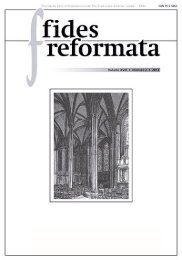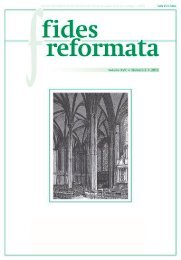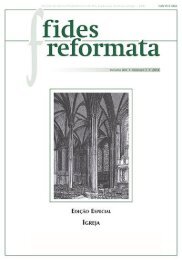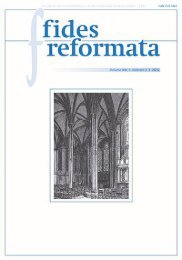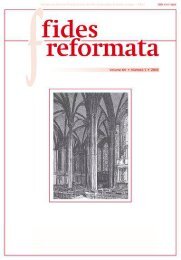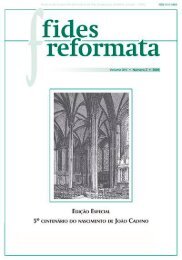You also want an ePaper? Increase the reach of your titles
YUMPU automatically turns print PDFs into web optimized ePapers that Google loves.
FIDES REFORMATA XIX, Nº 2 (2014): 95-115<br />
2.4 The author has the last word<br />
The singular of verse 25 still needs our attention now. The phrase “I<br />
suppose” (οἶμαι) expresses humility on the part of an ancient author who is<br />
making his own comment to his readers.<br />
Furthermore, as Andreas Köstenberger shows after extensive research,<br />
it is an “integral part of the authorial perspective.” 44 In antiquity there is no<br />
precedent for such usage of οἶμαι by a later editor or a group of editors. In<br />
fact, why should one voice from a group of editors still add a last word? The<br />
probability is much greater that the author himself has the last word, considering<br />
the just given testimony of the “we-group” of which he is a constituent.<br />
The “I-form” is prepared by the impersonal construction of the statement of<br />
purpose (20:30-31).<br />
Moreover, it has become possible through the author’s identification<br />
with the beloved disciple in verse 24a. The argument that the author never<br />
speaks in the first person singular 45 is not valid at the conclusion of the book<br />
anymore. The writer of the Gospel of John gives his own commentary in the<br />
verses <strong>19</strong>-20, starting already from verse 23. 46 Therefore, verse 25 presents<br />
a self-conscious author who at the end is reflecting modestly on his starting<br />
point, namely that he has written this book.<br />
Finally, verse 25 is not a substantial duplication of 20:30-31. John is not<br />
a book with two endings. Foremost, because John 20:30-31 is not an ending<br />
but a statement of purpose.<br />
Πολλὰ μὲν οὖν καὶ ἄλλα σημεῖα ἐποίησεν ὁ Ἰησοῦς ἐνώπιον τῶν μαθητῶν<br />
[αὐτοῦ], ἃ οὐκ ἔστιν γεγραμμένα ἐν τῷ βιβλίῳ τούτῳ: ταῦτα δὲ γέγραπται<br />
ἵνα πιστεύ[σ]ητε ὅτι Ἰησοῦς ἐστιν ὁ Χριστὸς ὁ υἱὸς τοῦ θεοῦ, καὶ ἵνα<br />
πιστεύοντες ζωὴν ἔχητε ἐν τῷ ὀνόματι αὐτοῦ. 47<br />
Many other miraculous signs did Jesus in the presence of his disciples,<br />
which are not written <strong>do</strong>wn in this book, but these are written that you<br />
44 KÖSTENBERGER, Andreas J. ‘I Suppose’ (οἶμαι): The Conclusion of John’s Gospel in Its<br />
Literary and Historical Context. In: WILLIAMS, Peter J. et al. (eds.). The New Testament in Its First<br />
Century Setting. Essays on Context and Background. FS Bruce W. Winter; Grand Rapids: Eerdmans,<br />
2004, p. 72-88 [87].<br />
45 BAUM, Observations, p. 151. Baum himself indicates that there is a partial analogy between the<br />
books of John and Acts, if one considers the “we-passages” from Acts as biographical. In the prologue<br />
of Acts Luke uses an “I-form” (see also BAUM, Autobiografische Wir- und Er-Stellen).<br />
46 RESE, Selbstzeugnis, p. 89.<br />
47 The text-critical issue (πιστεύητε with the aspect of duration: “so that you would continue to<br />
believe” or πιστεύσητε with the aspect of an aorist: “so that you begin to believe”) <strong>do</strong>es not need to be<br />
touched here since it <strong>do</strong>es not have bearing on the theme of this article; about that see: van HOUWELIN-<br />
GEN, Johannes, p. 399; ANDERSON, The Riddles of the Fourth Gospel, p. 85-87; VAN DER WATT,<br />
Jan G. An Introduction to the Johannine Gospel and Letters. Lon<strong>do</strong>n: T&T Clark, 2007, p. 10-11.<br />
111






